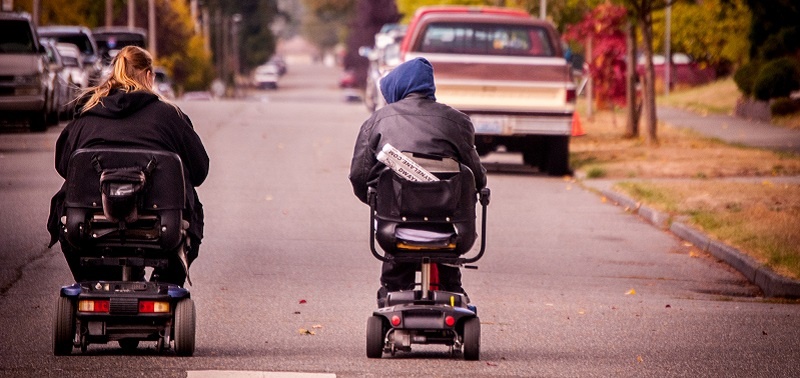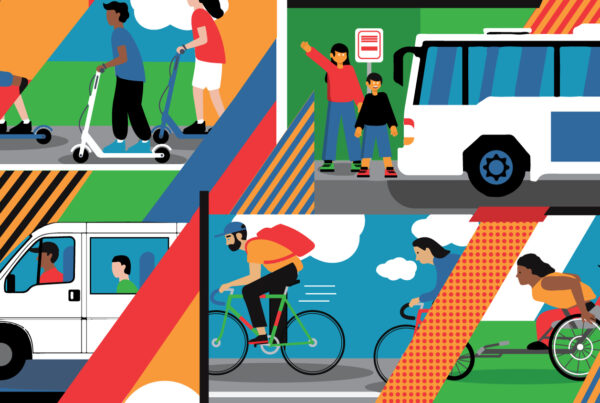Thanks in part to the Silicon Valley hype machine, it’s no longer difficult to imagine a car tooling down the street without a driver behind the wheel. But have you seen a rendering of a driverless car that can accommodate a person with a wheelchair? Or a guide dog?
Autonomous vehicles have the potential to offer many significant benefits to cities, from reducing auto crashes and traffic congestion to opening up more space for parks, bike lanes and transit corridors. However, they could be especially transformative for one group of people in particular—those who can’t drive.
In the United States, nearly one in every five people, or more than 57 million, has a disability. Of those, some six million currently have difficulty getting the transportation they need. That includes deaf people, blind people, and those with physical mobility issues that require the use of a wheelchair. Additionally, more than one in five elderly Americans can no longer drive. Meanwhile, the population of U.S. residents over the age of 65 is expected to skyrocket from 40 million to 88 million by 2050.
If self-driving cars will one day be rolled out on a large scale, it only makes sense to design and build them with these millions of Americans in mind. Earlier this year, a group of disability advocates—including the Disability Rights Education & Defense Fund, National Center for Aging and Disability, and Independent Living Research Utilization—met to discuss the state of autonomous vehicles and what the evolution of self-driving technology might mean for people with disabilities.
The group offered several suggestions for automakers, tech companies, regulators and other self-driving stakeholders to help ensure the benefits of AVs are accessible to all—especially to non-drivers who might stand to benefit most from these technological advances.
Designing Vehicles and Hardware with Adaptive Uses in Mind
Automakers can help ensure autonomous vehicles are accessible by taking the needs of disabled riders into consideration early on when designing and building self-driving cars, especially Level 4 and 5 vehicles (high automation to full automation) that may look less and less like the cars we know today. Possible alterations include:
- Designing vehicles with lower floors to accommodate wheelchair users
- Including wheelchair lifts or ramps, or providing support for similar aftermarket modifications
- Providing accessible door handles, securement options and storage spaces (including those large enough to stow a wheelchair)
Creating Accessible User Interfaces
Even though they won’t be driving, passengers will still need to interact with the vehicle to plan their trip, monitor their route and safely enter and exit the vehicle. Without adaptive measures, these tasks could be challenging, if not impossible, for people who have difficulty seeing or hearing, as well as for people with cognitive disabilities. Automakers and tech companies can help assist these users by:
- Providing a voice-controlled system option that would allow passengers to unlock doors, lower or raise windows, change their route and more by using voice commands
- Creating visual displays with adjustable size/contrast options
- Including accessible operating surfaces that feature tactile cues and customized assistive technology, such as paperless Braille displays for deaf-blind users
- Ensuring the navigation system orients users during the ride and at their drop-off point, such as by providing audio and visual information about the environment surrounding the vehicle, directions on exiting using available adaptive features, and last-mile directions to their destination including orientation landmarks
Navigation systems should also be prepared to communicate with passengers during the ride—such as explaining deviations from the route or why the vehicle may be stopping—as well as in the event of an accident or other roadway incidents that obstruct travel.
Ensuring Ride-Hailing Tech and Apps are Accessible
The potential challenges for a disabled rider might begin before the trip is even underway. For instance, will he or she be able to book a ride and locate the car once it arrives? To address these needs, providers may want to consider:
- Developing ride-hailing apps with enhanced audio and visual options for passengers with difficulty seeing or hearing
- Ensuring that vehicles are able to identify disabled passengers and respond accordingly
- Offering “micro-navigation” cues for blind riders to help them locate and enter a vehicle once it has arrived
- Creating navigation systems that can identify and use wheelchair-accessible pick-up and drop-off points, if needed
More information on the implications of autonomous vehicles for people with disabilities can be found in this whitepaper from the Ruderman Family Foundation and a report from the National Council on Disability. To keep up on the latest trends across the shared mobility industry, be sure to sign up for SUMC’s weekly newsletter.
Image credit: Cindy Shebley


